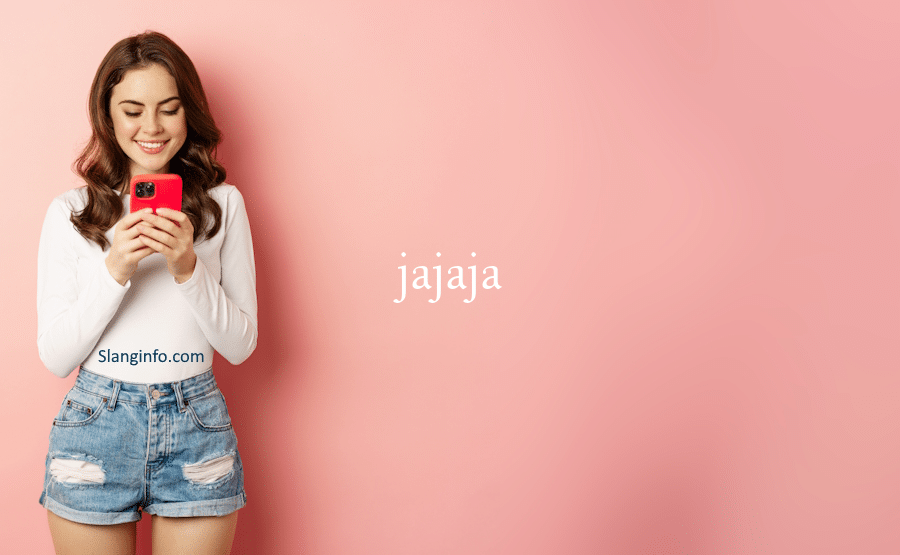Have you ever chatted with a Spanish-speaking friend online and seen them respond with “jajaja“? If you’re not familiar with Spanish, you might have been confused. Don’t worry! This article will explain everything you need to know about “jajaja“, the Spanish-language equivalent of “hahaha“.
Key Takeaways
| Aspect | Details |
|---|---|
| Meaning of “Jajaja” | Represents laughter in Spanish, similar to “hahaha” in English. |
| Phonetic Basis | “J” in Spanish sounds like “H” in English, making “jajaja” phonetically identical to “hahaha.” |
| Cultural Variations | Variants like “jejeje” or “jujuju” indicate different levels or types of laughter, with regional differences across Spanish-speaking countries. |
| Comparison Across Cultures | Other countries use different expressions, such as “555” in Thai, “kekeke” in Korean, and “wwww” in Japanese. |
| Role in Communication | Used to convey friendliness, soften tones, or indicate sarcasm in digital conversations. |
What Does “Jajaja” Mean?

At its core, “jajaja” is the Spanish equivalent of “hahaha,” representing laughter in written form. The difference is rooted in language sounds: in Spanish, the letter “J” is pronounced like an English “H,” which explains why Spanish speakers type “jajaja” instead of “hahaha.” This simple shift hints at larger cultural differences in how people express humor across languages.
Phonetic Roots of “Jajaja”
The letter “J” in Spanish has a distinct sound that many non-native speakers find challenging to pronounce—it’s a throaty sound that resembles the English “H.” Therefore, when Spanish speakers want to convey laughter, they naturally lean toward “jajaja.”
While it may seem small, this phonetic detail highlights an interesting aspect of linguistic diversity. As people communicate more and more through text, the way laughter is represented has adapted to fit the language’s phonetic characteristics.
Fun Fact: In some regional dialects, you might even see variations like “jejeje” or “jujuju,” each carrying a slightly different tone. These variations can indicate sarcasm, nervousness, or even a chuckle.
Cultural Nuances of Digital Laughter
Laughter is universal, but how it’s expressed in writing can vary widely. Here are some other notable ways people convey laughter online:
Different Forms of Laughter in Other Languages:
- Thai: “555” – In Thai, the number 5 is pronounced “ha,” so “555” sounds like “hahaha.”
- Japanese: “wwww” – The letter “w” is short for “warau,” which means “to laugh.”
- Korean: “ㅋㅋㅋ” (keukeu) – Represents a sound similar to giggling or chuckling.
- French: “mdr” – Short for “mort de rire,” which means “dying of laughter.”
Exploring these differences can help us appreciate how language influences communication styles. Each expression carries subtle nuances that native speakers intuitively understand.
Cultural Comparison of “Jajaja” and “Hahaha”
While both “jajaja” and “hahaha” essentially mean the same thing, their use reflects cultural variations in humor. For example:
- Spanish-speaking cultures often use “jajaja” in a friendly, casual way, and it frequently appears in conversations to express lightheartedness or add a warm tone.
- In English, people use “hahaha” or even “lol” to indicate laughter. “Haha” can sometimes be used sarcastically, while “lol” has become almost neutral, often indicating mild amusement.
Because these cultural nuances affect communication, understanding them can prevent misunderstandings and enrich interactions with speakers from different backgrounds. For more on digital communication styles and their meanings, check out How People Use “kkkk” for Laughter.
How “Jajaja” Affects Social Interaction Online

In digital communication, written laughter helps us convey emotion where vocal tone and body language are missing. Spanish speakers use “jajaja” not only to express laughter but also to:
- Softens the tone of a message, making it feel less direct or harsh.
- Indicate sarcasm when paired with certain emojis or other language cues.
- Show friendliness in casual conversations.
For instance, if someone were to write, “No te creo jajaja” (“I don’t believe you hahaha”), the “jajaja” at the end makes the phrase lighthearted rather than accusatory. The absence of “jajaja” might make it sound serious or confrontational. This flexible use of laughter makes “jajaja” an essential tool in online interactions.
Pro Tip: If you’re chatting with someone from a Spanish-speaking country, try using “jajaja” instead of “haha.” It can help bridge cultural gaps and make your conversation feel more natural.
Variations of Laughter Within Spanish-Speaking Cultures
Interestingly, even within the Spanish-speaking world, there are regional variations of digital laughter. Here are a few:
- Jejeje – Often conveys a chuckle or a softer laugh, sometimes used to imply a sly or mischievous undertone.
- Jujuju – Used to express laughter that feels more subdued or even sinister in certain contexts.
- Jjajaja – When laughter gets intense, some might even double the initial “J” to give the impression of someone really laughing out loud.
These slight modifications can add layers of meaning to a simple laugh. So, next time you see “jejeje” or “jujuju,” know that there’s a subtle nuance at play!
To see other interesting digital expressions like this, check out our article on How People Express Amusement with “Tinkerdinky”.

Why Understanding “Jajaja” Matters in Digital Communication
As online communication grows, it’s more important than ever to recognize and respect linguistic differences. Understanding terms like “jajaja” helps bridge cultural divides, enabling smoother, more empathetic interactions. Laughter expressions are small but powerful tools that can shape our tone, show empathy, and even diffuse tension in conversations. Here are some reasons why understanding “jajaja” matters:
The Impact of “Jajaja” on Tone and Perception
Laughter in text form, like “jajaja,” plays a significant role in how messages are perceived. For example:
- Softening Negative Feedback: Adding “jajaja” can soften a message, making it seem less critical. E.g., “¡Qué desastre! Jajaja” conveys a humorous spin rather than criticism alone.
- Conveying Affection: “Jajaja” can add warmth to interactions, especially in friendly chats or when responding to a joke.
- Easing Awkwardness: It’s often used to lighten awkward or tense moments, similar to how people laugh in uncomfortable situations in real life.
Consider the sentence: “No sé si eso es cierto jajaja.” Without “jajaja,” it could sound skeptical or challenging. With it, the sentence comes off as playful, perhaps indicating disbelief mixed with amusement.
How to Use “Jajaja” and Similar Expressions Correctly
If you’re trying to connect with Spanish-speaking friends or acquaintances, using “jajaja” instead of “hahaha” can create a more authentic connection. Here are some tips on using it effectively:
- Match the Tone: Use “jajaja” casually and freely in informal chats or when responding to jokes.
- Use Variations for Effect: Try “jejeje” for a sly laugh or “jujuju” if you’re aiming for a slightly mischievous tone.
- Watch for Context: Keep in mind that adding too many “ja’s” (like “jajajajajaja”) can convey intense laughter or even make it seem like you’re laughing at something instead of with someone.
Pro Tip: If you’re not sure which laughter form to use, stick with “jajaja.” It’s widely understood and fits into almost any Spanish-speaking context. For more tips on using digital slang and expressions, check out How to Express Different Types of Laughs with “Hahaha” Variants.
Laughter Variations and Emojis: Adding More Flavor
Today’s digital communication often combines text-based laughter with emojis or gifs to further express emotions. Spanish speakers might pair “jajaja” with a laughing emoji 😂, or sometimes use the popular laughing-crying face 😂 for even greater emphasis.
- Laughing Emojis: Pairing emojis with “jajaja” can add a visual layer, making your message clearer. For example, “jajaja 😂” shows that you’re laughing quite hard.
- Gifs and Memes: In response to something especially funny, you might see “jajaja” accompanied by a popular meme or gif, making the laughter more expressive and culturally relevant.
Combining these elements helps convey a fuller emotional range, making online communication feel more authentic and personal. This reflects a broader trend where people across the world adapt language to digital contexts, creating new ways to connect despite linguistic barriers.
Real-Life Implications and Digital Communication Tips
Understanding the meaning behind terms like “jajaja” can make digital interactions smoother and more enjoyable. Knowing when and how to use these expressions helps avoid misunderstandings and fosters cross-cultural connections. Here’s a quick guide for effectively navigating laughter in digital chats:
Quick Guide to Digital Laughter Across Cultures
- Be Aware of Regional Variants: Different cultures have unique ways of expressing laughter. For example, “kekeke” in Korea and “555” in Thailand carry distinct meanings but serve the same purpose.
- Use Emojis Wisely: Emojis can reinforce the tone of your laughter. Adding 😂 or 😆 to “jajaja” amplifies your laughter and helps convey the exact emotion.
- Experiment and Adapt: If you’re communicating with someone who uses “jajaja,” try using it as well to show cultural awareness and foster a sense of closeness.
For more on how emojis can change the tone of your messages, see Why the Purple Heart Emoji Has Multiple Meanings.
Conclusion
Understanding “jajaja” opens a window into Spanish online culture. It’s more than just a laugh – it’s a way of expressing identity, humor, and warmth in the digital world. Whether you’re learning Spanish, chatting with Spanish-speaking friends, or just curious about internet linguistics, knowing about “jajaja” adds a valuable piece to your global communication toolkit.
So next time you see a string of “ja”s in a comment section or chat, you’ll know – someone in the Spanish-speaking world is having a good laugh!
FAQs
- Is “jajaja” used in spoken Spanish?
No, it’s primarily a written expression. In speech, Spanish speakers laugh just like in any other language. - Can I use “jajaja” if I’m not a Spanish speaker?
Yes, but be mindful of the context. It’s a great way to engage with Spanish-language content authentically. - Is there a limit to how many “ja”s I should use?
There’s no strict rule, but typically 2-5 “ja”s are common. More than that might be used for extreme hilarity. - Does “jajaja” always mean genuine laughter?
Like “haha” in English, context matters. It usually indicates genuine amusement, but could be sarcastic in certain contexts. - How is “jajaja” different from “LOL”?
“Jajaja” is a direct representation of laughter, while “LOL” is an acronym. “Jajaja” is generally seen as more expressive and genuine.
If you’re interested in exploring more online slang and expressions, you might want to check out our articles on CNC meaning or TTM meaning. For those curious about other cultural expressions, our piece on Antarvasna offers insights into Indian erotic literature.







